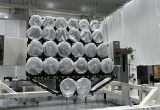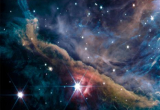How many earth-like planets orbit the habitable zone of solar-like stars? How planets form and evolve in their planetary systems? What about the interaction with their stars? These are among the questions the ESA PLATO mission is called to answer, through exquisite measurements of exoPLAnet Transits and Oscillations of stars (you now know the origin of the PLATO acronym). The “transit” measurements yield information on the size of the planets, while the “stellar oscillations” give us the mass and age of the stars, which in turn are fundamental to assess the mass and age of the hosted planets. The exquisite quality of all such measurements is secured by 26 ultra large field-of-view cameras that make the eyes of the PLATO mission.
You are here
Archive
An international team, involving scientists from IAS, IRAP, ISMO and LERMA, has shed light on the destruction and reformation of a large quantity of water in the planet-forming disk “d203-506” located at the heart of the Orion Nebula. This discovery was made possible by an original multidisciplinary approach that combines observations from the JWST space telescope and quantum physics calculations. The study, carried out as a part of the PDRs4All¹ Early Release Science (ERS) program and led by Marion Zannese, a PhD student at the Institut d’Astrophysique Spatiale, has been published in Nature Astronomy.
Best wishes for 2024 from the Institut d'Astrophysique Spatiale !
The electronic greeting card can be found here.






